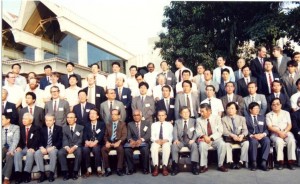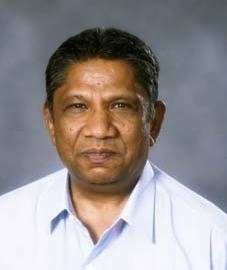 This interview was made in December, 2012, in Prof. Balasubramaniam’s office in the Gold Coast Campus of Griffith University, Queensland, Australia. After that, he prepared the first draft of this article in which he is talking to me. I made minor modifications in his draft with his permission. For readers’ convenience, it should be stated that Prof. Bala worked for 27 years at the Asian Institute of Technology (AIT) in Thailand and educated many promising people from many countries of Asia.
This interview was made in December, 2012, in Prof. Balasubramaniam’s office in the Gold Coast Campus of Griffith University, Queensland, Australia. After that, he prepared the first draft of this article in which he is talking to me. I made minor modifications in his draft with his permission. For readers’ convenience, it should be stated that Prof. Bala worked for 27 years at the Asian Institute of Technology (AIT) in Thailand and educated many promising people from many countries of Asia.
Ikuo Towhata, Editor of BULLETIN
1: Prof. Bala, tell us a bit about your family background and schooling
Yes, Ikuo, before that; let me say a few words of when you joined AIT in early 1980; Prof. Nishino was our Vice President and he told me that you are rather unique—In Japanese academic system, the Age counts a lot and in the Tokyo University Departmental meeting, when the Chairman said in a formal meeting, Does anybody have any questions. Everyone was surprised, when you raised your hands.
I was born for Sri Lankan Parents in Malaya and returned to Sri Lanka in late 1940’s. I am really a village boy; in the northern part of Sri Lanka. I must say we are all proud of our School education in Sri Lanka.
2: So, Prof. Bala, what made you in this Journey to select Geotechnical Engineering?
Oh, that is interesting Ikuo, I was given a Scholarship to do Doctoral Studies. I had no idea what to do; as up to then, I was merely dependent on my lecture notes and hardly any research experience. But I must say, our lecturers are all Cambridge and Imperial College educated ones. They are truly remarkable. You must know Thurairajah, Ikuo. We call him Thurai, who just returned from Cambridge and taught us about 20 hours of Soil Mechanics. At that time, Soil Mechanics go with Structures. Earlier, Soil Mechanics was taught by our Dean Prof. Pereira who used to teach old earth pressure theories.
So, I went to Thurai and said, I like to do research work in Soil Mechanics on this scholarship. Thurai said, he can recommend me to Cambridge, but be sure not to change your mind later. I only understood the weight age of this statement, when I met Roscoe at Cambridge; it told me a lot of how Thurai appreciated the sentiments and temperament of the late Prof. Roscoe.
In any case Thurai gave three papers to read; one written by Roscoe, Schofield and Wroth in 1958, the other by Roscoe & Poorooshasb in 1963 and the third by Roscoe Schofield and Thurairajah in 1963. All three published in Geotechnique.
3: So, how do you find them reading, Prof. Bala?
It was frankly very tough going, more like torturing. No wonder, Thurai warned me about changing my mind. I read them over and over again. I may have done that more or less over thirty or forty times. Thurai also asked me to read the sections on Shear Strength by D.W. Taylor in his book on Fundamentals of Soil Mechanics. I had some time the feeling, I understood some of them and also a feeling, I did not understand anything.
4: So, when did you go to Cambridge?
Ikuo, at that time the Sri Lankan Scholars took Boats to go to UK. I was on a P&O liner which took about twenty two days to reach London. To be frank, at that time, I only knew Jaffna my home place and Colombo where I was in the University. So, going outside of Sri Lanka was a great learning curve and the Boat trip made my transition a bit easier.
5: Prof. Bala, how was your meeting with Roscoe and others?
I was briefed very well that Roscoe is pretty strict and I need to be very careful. Thurai advised me; perhaps I should take a bottle of Arrack (Sri Lankan equivalent of Whisky) from Sri Lanka and some tea. So, I took these and went to see Ken Roscoe in his Office which was in the third floor of a four storey building. Maybe knowing that I am rather nervous, Ken Roscoe was polite with me.
He asked whether I know any Soil Mechanics. I replied very little, but added I read his three papers. He then asked me how my English is. At Cambridge, I got into some X ray business first. I must thank god for getting out of that and settled later on the experimental work related to the Critical State soil Mechanics.
I also met Prof. Schofield and late Peter Wroth. Andrew was looking for some students to work on Centrifuge and also Cavity Expansion. I did not touch them. Peter Avgherinos in our group of four went into Centrifuge. My advisor was Jimmy James as based on my initial interest in X rays. Jimmy was a remarkable person, interested very much in gliding and flying. I certainly did not want to risk my life. I used to upset Jimmy. Roscoe advised me Jimmy is a nice guy and do not rub Jimmy on the wrong side.
At Cambridge I was very friendly with Dr. Ting Wen Hui from Malaysia and Demetri Coumulos. John Burland was also most helpful; all of them are. I even ran into Arthur Penman who gave a lecture on Dams. Roscoe had many visitors: Gudehus, Leonards, Ron Scott, etc etc.
6: So, how did you went to NGI, Prof. Bala?
It was also an accident Ikuo. When I was in the beginning of my third year, I applied for some job in Sri Lanka. I did not get it. Roscoe used to jokingly say, I was the first person whom he wrote a letter of recommendation and did not get a job. He then added, Laurits Bjerrum the President of the International Society will give the Rankine Lecture and will visit Cambridge also and give a Lecture. Actually, I attended the previous Rankine Lecture by Prof. Bishop and got lost in London. I am not used to big cities. The idea of working with the President of the International Society really appealed to me. That is how; I developed my interest with ISSMGE.
7: Tell us a little bit Prof. Bala about NGI and your work
My doctoral thesis at Cambridge was a bit delayed. I got it vetted by Roscoe. It is remarkable Roscoe can sit with a student and read word by word a thesis and ask what you mean by that and correct it and say, then why don’t you express that way. Roscoe was a remarkable person. He not only did that, but also took us to his home for lunches and dinners. I had four Christmas breaks with Roscoe, Mrs Roscoe and their children.
In any case, I landed in Fornebu Airport in February 1969; my flight was a bit delayed. I was really shocked by the vast amount of snow. Next day morning, I was picked up by a person to see Bjerrum. This person took me to see Bjerrum and said, finally Mr B has arrived. They have abbreviated my name. Then Bjerrum looked at the person who picked me up and said, you will work with Elmo. That was a great surprise for me. Such a simple and modest person. Elmo was a fantastic Instrumentalist, while I knew nothing about it. Bjerrum always knew how to open the eyes of us. I learned a lot from Elmo and was involved in many important projects.
I met two persons at NGI and it seemed their friendly discussion was a great help. One is Prachit Chiruppapa from Chulalongkorn University, who talked a lot about AIT and Dr. Moh, and the other was David Nash, son of Kevin Nash.
8: We remember you were also teaching at Peradeniya in Sri Lanka
Yes, I returned to Sri Lanka in March 1970 and with great difficulty got a lecturer position in the University mainly through the most valued help of Thurai. It was very nice working with Thurai. We revised the Civil Engineering Curriculum and introduced a Masters Degree. I remember writing world wide to prominent people asking for their advice, their syllabus and also publications and possible old equipment. Among the people replied were Casagrande with his question papers in Harvard. Prof. Harry Seed from Berkeley, Prof. Gerry Leonards from Purdue, Prof. Bengt Broms from SGI and Prof. Dinesh Mohan from Central Building Research Institute India. I used my own money in mailing expenses. We got a large amount of publications. Kevin Nash was invited to give a lecture; Kevin also thought Ralph Peck would be more prestigious.
I remember sleeping in the Soils Lab to take readings in our triaxial apparatus around the clock. No automatic data logging. This work was published in the Tokyo Conference in 1977. I used to get AIT News Letter and was really impressed with their activities and their presence in an international scene. In one issue of the newsletter, I saw advertisements for opening Geotechnical Engineering. I applied for it. Nothing was happening for a year or so, all of a sudden, there was an interest and a letter from Dr. Moh. I remember Ted Brand visiting us as well. Dr. Moh made an offer in May 1972 as an Assistant Professor with a salary of about 800 Dollars per month. I accepted it; even though I was enjoying my work at Peradeniya.
9: Was your movement to AIT was a turning point, Prof. Bala?
Yes Ikuo it was. Dr. Moh was a remarkable and tough administrator. Also very kind. I had full support from him. My early Colleagues were Ted Brand, Peter Brenner and Prinya Nutalaya. I am sure you know all about them.
At AIT, Dr. Moh asked me to become the Secretary General of the Southeast Asian Geotechnical Society (SEAGS). There you are, I became and as the SG since I retired in July 2001. Through SEAGS, I was very much involved in ISSMGE and initially Kevin Nash.
10: How was AIT in terms of Research?
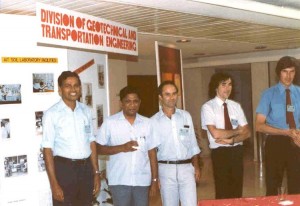
One of the memorable moments of Prof. Bala at AIT
Oh, Dr. Moh must really be very proud of his contributions to AIT. He was only given an Honorary Doctorate Degree. The research and teaching facilities were excellent. We had about 300 hours of lectures to our Masters Students. Most of them ended up doing Doctoral studies in USA, Japan, Canada and other countries. Also many became excellent engineers here in Australia, USA, Canada and Asia. We later recruited Dennes Bergado and Sarvesh Chandra. Dennes had a remarkable career. Even Indraratna had his first appointment with us, before he moved to Wollongong. AIT was involved in almost all the major projects in Bangkok and also in Thailand. Prinya is a fantastic Engineering Geologist. His work on Bangkok Subsidence will live forever. We had Yudhbir, Onodera, Akagi, Ohta, Yamada, yourself, Kuwano, Prinzl, Tomiolo, Rantucci, Noppodol and many others; all very able and prominent persons.
11: Southeast Asian Geotechnical Society & activities: what can you tell us?
Ikuo, AIT and Southeast Asian Geotechnical Society are both part of my life. I worked with SEAGS Presidents: Prof. Chin, Peter Lumb, Tan Swan Beng, Ted Brand, Ting Wen Hui, Prof. Lee, Ou Chin Der, Surachat, Dr. Ooi and John Li; all excellent people. The fifth Southeast Asian Conference had Nordi Morgenstern, Prof. Chin, Dr. Arthur Penman and Dr. Ian Donald as guest lecturers. Also, the back to back, International Symposium on Soft Clays arranged by Ted Brand and Peter Brenner was a huge success with Nils Flodin, Bengt Broms, Harry Poulos, Mike Duncan, Andresen Elmo Dibiagio, Peter Wroth, Dick Parry and many others.
Also, the Ninth Southeast Asian Regional Conference was held in 1987.
We had Asian Regional Conferences in Singapore in 1979 and in Bangkok in 1991. These were indeed some of the finest conferences we had. Always with international participation >> Read more
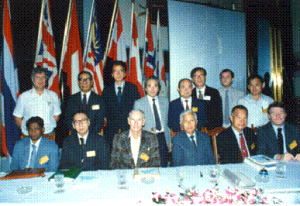
General Committee of South Eastern Asian Geotechnical Society during the 9th SEAGC in Bangkok (1987)
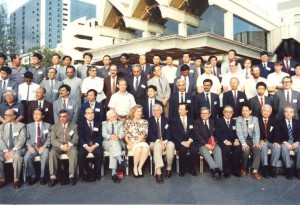
Group photo during the 9th Asian Regional Conference on Soil Mechanics and Foundation Engineering in Bangkok (1991)